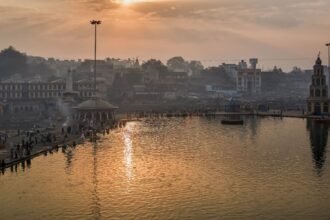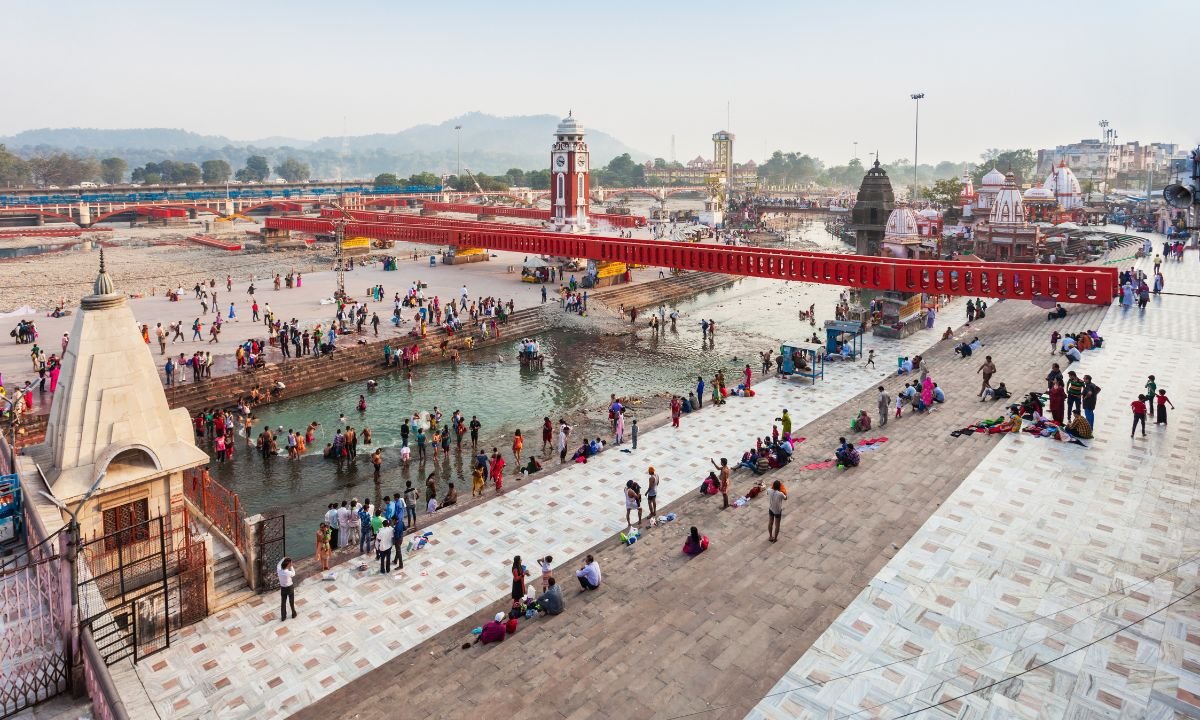Every Kumbh Mela transforms its host city – but the infrastructure for Kumbh Mela 2027 in Nashik is setting a new standard. As millions of pilgrims prepare to gather at the sacred Godavari ghats, the city is undergoing a spiritual and infrastructural metamorphosis, balancing tradition with technology and devotion with design.
- Infrastructure for Kumbh Mela 2027
- 1. Road Widening and Highway Expansion
- 2. Railway Station Modernization
- 3. Riverfront and Ghat Renovation
- 4. Water and Sanitation Systems
- 5. Tent Cities and Accommodation
- 6. Safety and Crowd Management Systems
- 7. Smart City Technology
- 8. Health and Medical Preparedness
- 9. Heritage Restoration and City Beautification
- 10. Eco-Friendly Initiatives
- In Conclusion
The Maharashtra Government, in collaboration with Nashik Municipal Corporation and national bodies, is building sustainable, smart, and inclusive systems to host the world’s largest spiritual congregation.
Infrastructure for Kumbh Mela 2027
Here’s a detailed look at the major infrastructure initiatives underway for Kumbh Mela 2027:
1. Road Widening and Highway Expansion
To ensure smooth traffic flow during Snan days:
- Widening key roads leading to Trimbakeshwar and Ramkund
- Creation of bypass routes and ring roads around Nashik
- Upgraded connectivity with Mumbai, Pune, Shirdi, and Aurangabad
- Enhanced bus terminals and auto stands for local access
These upgrades are designed to eliminate chokepoints and support emergency services during high footfall periods.
2. Railway Station Modernization
Nashik Road station will be more pilgrim-friendly:
- Longer platforms and new shelters
- Separate zones for arrivals and departures
- Digital signage in multiple languages
- More ticket counters, sanitation units, and drinking water points
Special trains from high-density states will help manage crowd surges.
Also read : Understanding the 12-Year Cycle of Kumbh Mela
3. Riverfront and Ghat Renovation
The Godavari ghats are the heart of Nashik’s Kumbh. Renovation includes:
- Reinforced Snan platforms and non-slip steps
- Wheelchair access ramps and safety railings
- Decorative LED lighting and landscaping
- Sewage and water treatment systems to preserve river purity
Aesthetic beauty is paired with spiritual sanctity and public safety.
4. Water and Sanitation Systems
Cleanliness is critical with millions of visitors:
- 24/7 water supply for tents and akharas
- Mobile toilets and hygiene stations across zones
- Wastewater suction and disposal services
- Partnerships with NGOs and local volunteers for cleanliness drives
This will make Kumbh 2027 one of the most hygienic pilgrimages ever.
5. Tent Cities and Accommodation
Entire tent townships will rise on Nashik’s outskirts:
- Dormitories, budget camps, and luxury tents
- Integrated first-aid, fire safety, and help desks
- Solar-powered lighting, modular kitchens, and waste systems
- QR-based digital check-in for smooth entry
Pilgrims across economic backgrounds will have safe, clean, and respectful lodging.
6. Safety and Crowd Management Systems
Crowd safety is paramount for Kumbh Mela 2027:
- Emergency bridges, exits, and evacuation plans
- Real-time CCTV monitoring and drone surveillance
- AI-based crowd density predictions for proactive response
- 10,000+ volunteers trained in first-aid and crowd behavior
An integrated command and control centre will oversee all activities live.
7. Smart City Technology
Nashik is embracing technology like never before:
- A Kumbh Mela 2027 app with ghat maps, alerts, and updates
- E-seva counters for registration and assistance
- AI-based chatbots in Hindi, English, and regional languages
- Public Wi-Fi and interactive digital kiosks across zones
This will empower pilgrims with real-time, helpful information at every step.
8. Health and Medical Preparedness
Healthcare will be deeply integrated into the infrastructure:
- Field hospitals with surgical and isolation units
- Round-the-clock ambulances and oxygen points
- Emergency care near ghats and Snan zones
- Trained AYUSH and allopathic staff for both holistic and medical care
Learnings from COVID have led to stronger public health measures than ever before.
9. Heritage Restoration and City Beautification
To retain Nashik’s sacred character:
- Restoration of ancient temples and spiritual sites
- Beautification of old town streets and religious corridors
- Spiritual-themed murals, fountains, and lighting installations
- Conservation of kunds, tanks, and heritage dharamshalas
The city will reflect both ancient heritage and modern grace.
10. Eco-Friendly Initiatives
Sustainability is a priority at every step:
- Eco-materials in tents and signage
- Complete plastic ban across Kumbh areas
- Plantation drives around ghats and pilgrim paths
- Live air and water monitoring for real-time environmental data
Kumbh Mela 2027 aims to become a benchmark for green religious tourism in India.
In Conclusion
The massive infrastructure for Kumbh Mela 2027 isn’t just about roads, stations, or toilets. It is about building a sacred, inclusive, and futuristic environment that respects the devotional pulse of the event while addressing 21st-century logistical needs.
As Nashik gets ready to welcome the divine tide, every footpath, LED light, and prayer space you encounter will reflect years of planning, service, and soul.
Come, witness a city transformed – not just by construction, but by consciousness.








